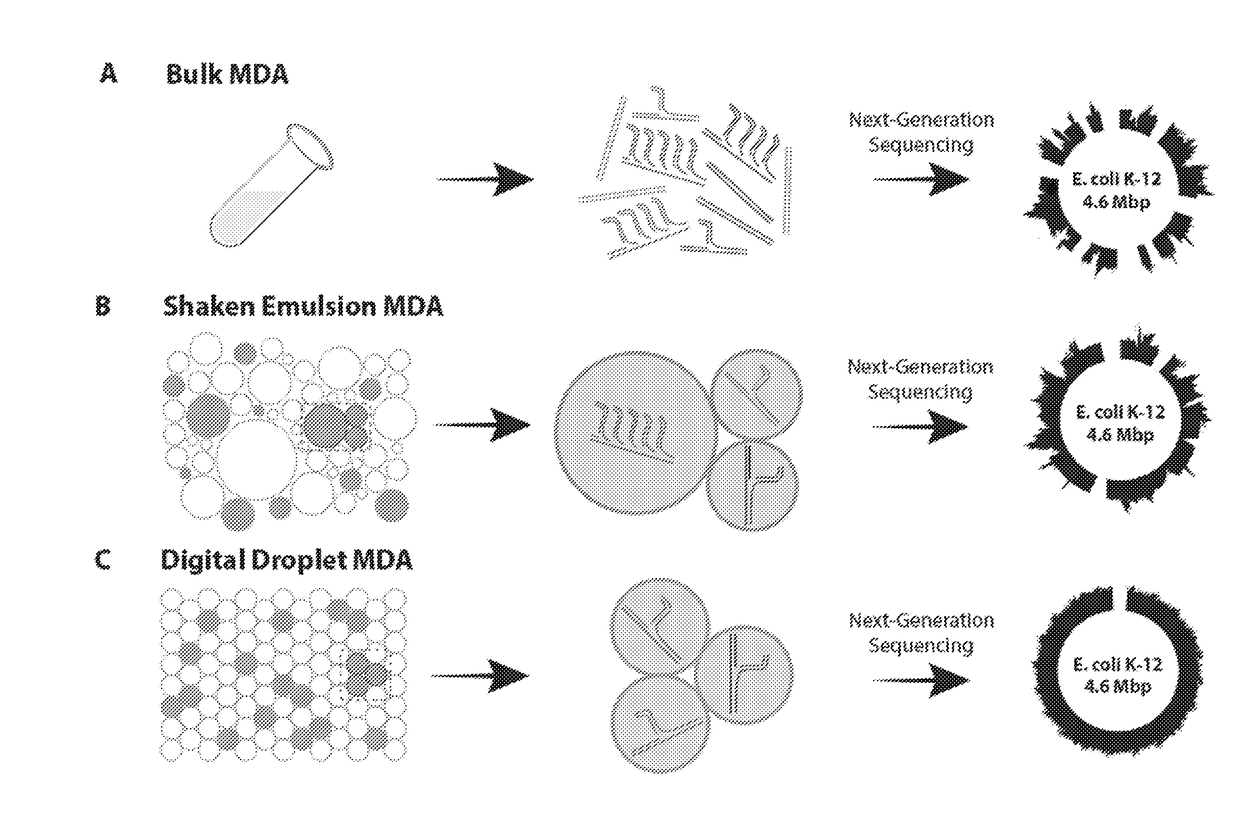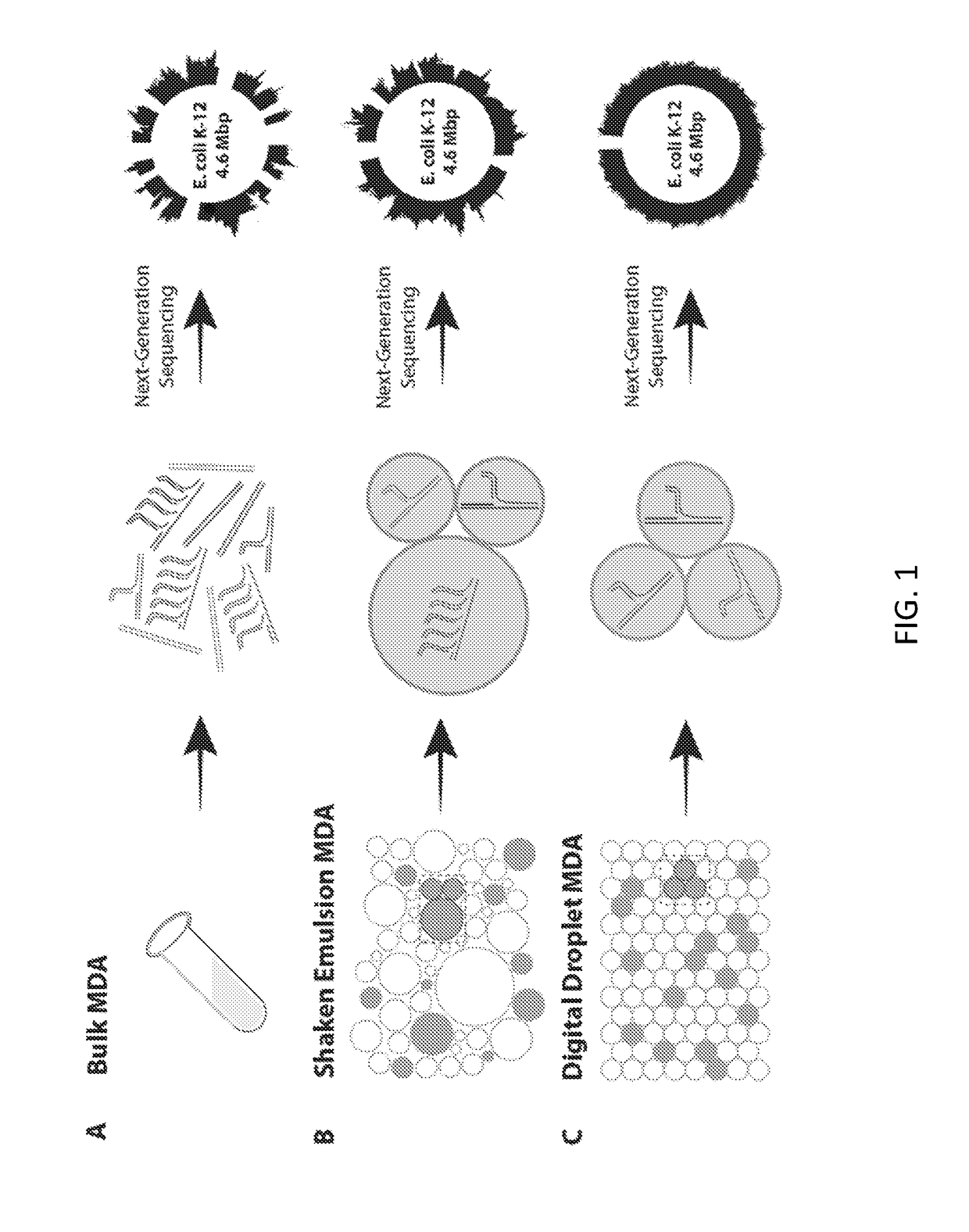Microdroplet-Based Multiple Displacement Amplification (MDA) Methods and Related Compositions
a technology of multiple displacement and amplification method, applied in the field of microdroplet-based multiple displacement amplification (mda) methods and related compositions, can solve the problems of reducing sequencing data quality, sequencing inefficient and costly, and non-uniform coverage, and achieves uniform coverage and enhanced accuracy
- Summary
- Abstract
- Description
- Claims
- Application Information
AI Technical Summary
Benefits of technology
Problems solved by technology
Method used
Image
Examples
example 1
on of Shaken Emulsion Droplets
[0218]Shaken emulsions were generated by adding 30 μL of HFE-7500 fluorinated oil (3M, catalog no. 98-0212-2928-5) and 2% (w / w) PEG-PFPE amphiphilic block copolymer surfactant (RAN Technologies, catalog no. 008-FluoroSurfactant-1G) to 30 μL of MDA reaction mixture. Alternatively, HFE-7500 fluorinated oil with 2% PicoSurf1 (Dolomite Microfluidics) can be used. The combined mixture was vortexed at 3000 rpm for 10 seconds using a VWR vortexer, creating droplets ranging in diameter from 15 μm to 250 μm (FIG. 8). At the conclusion of incubation, 10 μL of perfluoro-1-octanol (Sigma Aldrich) was added, the mixture was vortexed to coalesce the droplets, and the aqueous layer was extracted with a pipette. A detailed protocol for shaken emulsion formation can be found in Example 7 below.
example 2
on of Monodisperse Microfluidic Emulsion Droplets
[0219]The poly(dimethylsiloxane) (PDMS) microfluidic device used to generate monodisperse emulsions was fabricated by pouring uncured PDMS (10.5:1 polymer-to-crosslinker ratio) over a photolithographically-patterned layer of photoresist (SU-8 3025, MicroChem) on a silicon wafer (19). The device was cured in an 80° C. oven for 1 hr, extracted with a scalpel, and inlet ports were added using a 0.75 mm biopsy core (World Precision Instruments, catalog no. 504529). The device was bonded to a glass slide using O2 plasma treatment and channels were treated with Aquapel (PPG Industries) to render them hydrophobic. Finally, the device was baked at 80° C. for 10 min. Commercial microfluidic droplet makers and pumps may also be used to generate monodisperse emulsions for the methods described herein, e.g., ddMDA.
[0220]The MDA reaction mixture and HFE-7500 fluorinated oil with 2% (w / w) PEG-PFPE amphiphilic block copolymer surfactant (RAN Biotech...
example 3
n, Fragmentation, and Amplification of Genomic DNA
[0221]Purified E. coli K12(DH10B) cells were obtained from New England BioLabs (catalog no. C3019H), lysed, and purified using PureLink Genomic DNA Mini Kit (Life Technologies, catalog no. K1820-00). 10 kilobase fragments were gel-extracted following a 10-minute digestion with NEBNext dsDNA Fragmentase (NEB, catalog no. M0348S) of 800 ng DNA and quantified using a NanoDrop (Thermo Scientific). MDA reactions were performed using REPLI-g single cell kit (Qiagen, catalog no. 150343). Purified DNA (0.05 pg, 0.5 pg, and 5 pg) was incubated with 3 μL Buffer D2 and 3 μL H2O for 10 min at 65° C. After stopping by adding 3 μL stop solution, the reaction was divided in two and a master mix including nuclease-free H2O, REPLI-g Reaction Buffer, and REPLI-g DNA Polymerase was added to each partition. The MDA reactions were either incubated at 30° C. for 16 hrs in bulk or as an emulsion.
Example 4: Single E. Coli Cell Sorting and Whole Genome Ampli...
PUM
| Property | Measurement | Unit |
|---|---|---|
| internal volume | aaaaa | aaaaa |
| volume | aaaaa | aaaaa |
| internal volume | aaaaa | aaaaa |
Abstract
Description
Claims
Application Information
 Login to View More
Login to View More - R&D
- Intellectual Property
- Life Sciences
- Materials
- Tech Scout
- Unparalleled Data Quality
- Higher Quality Content
- 60% Fewer Hallucinations
Browse by: Latest US Patents, China's latest patents, Technical Efficacy Thesaurus, Application Domain, Technology Topic, Popular Technical Reports.
© 2025 PatSnap. All rights reserved.Legal|Privacy policy|Modern Slavery Act Transparency Statement|Sitemap|About US| Contact US: help@patsnap.com



